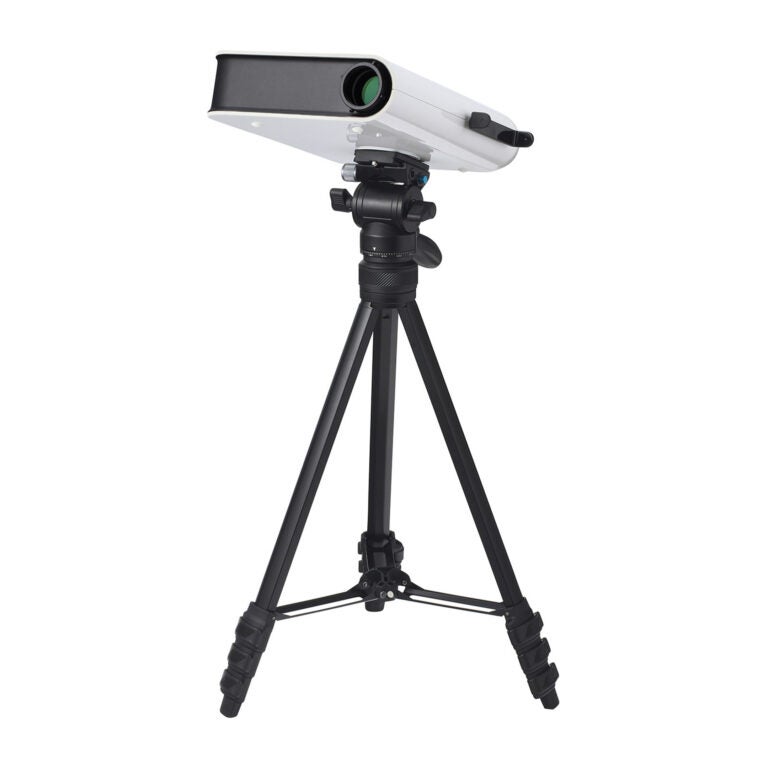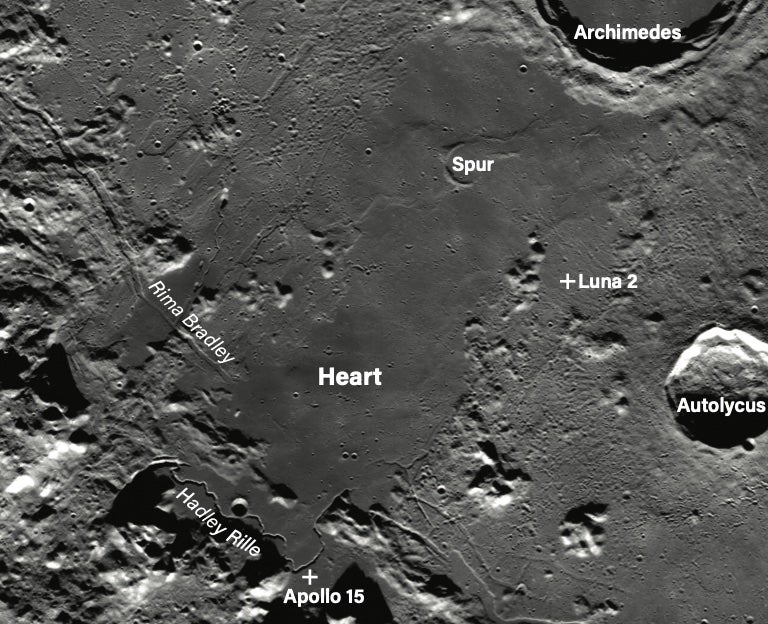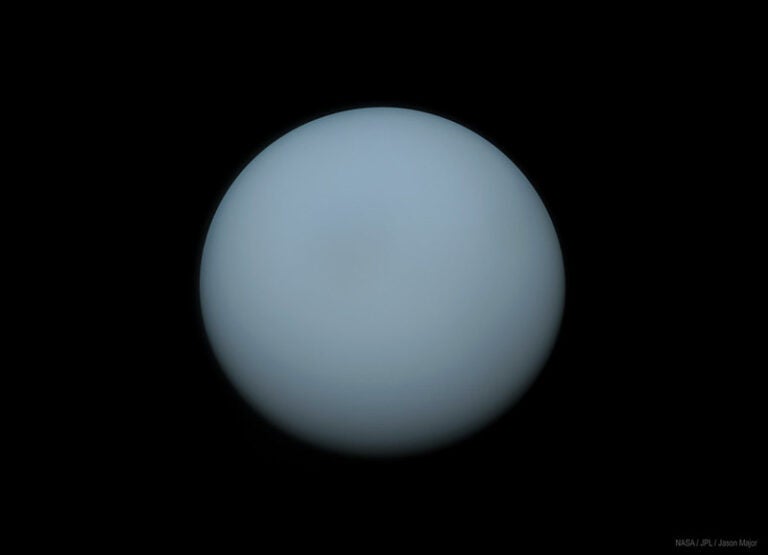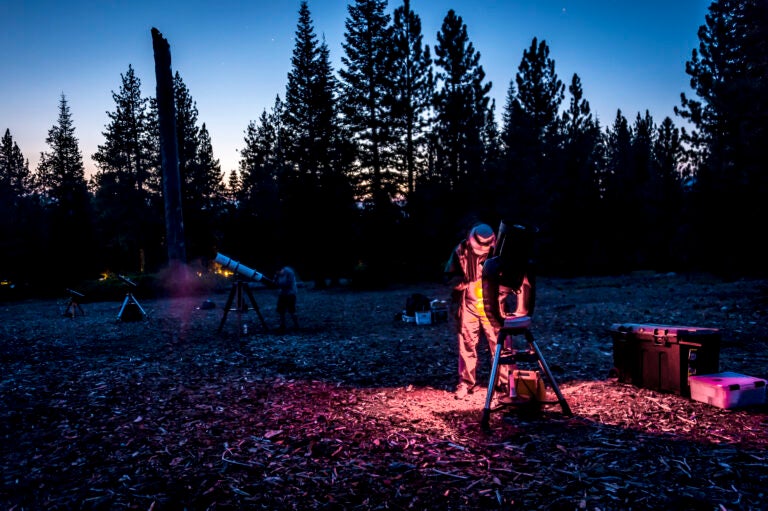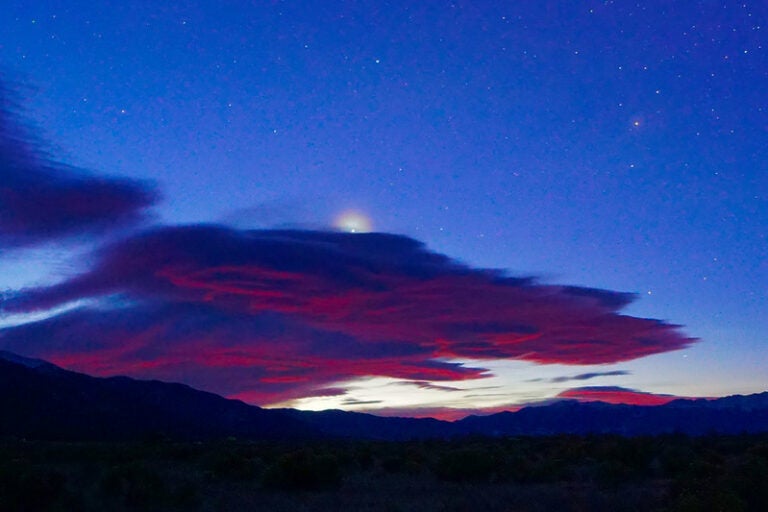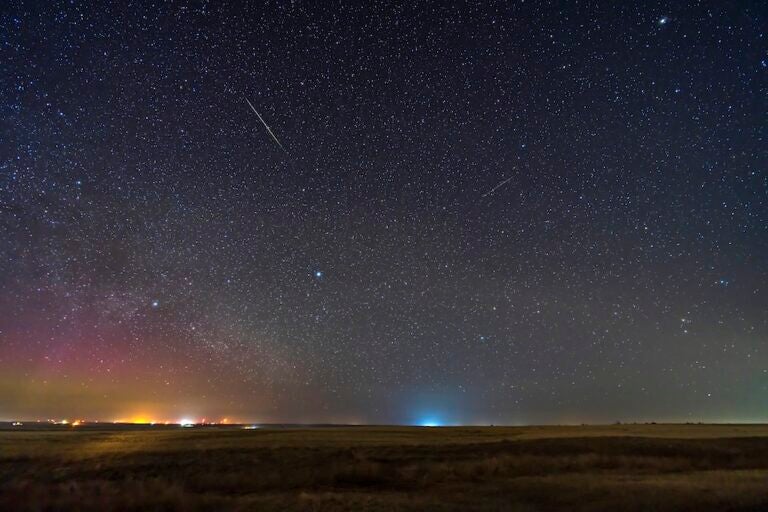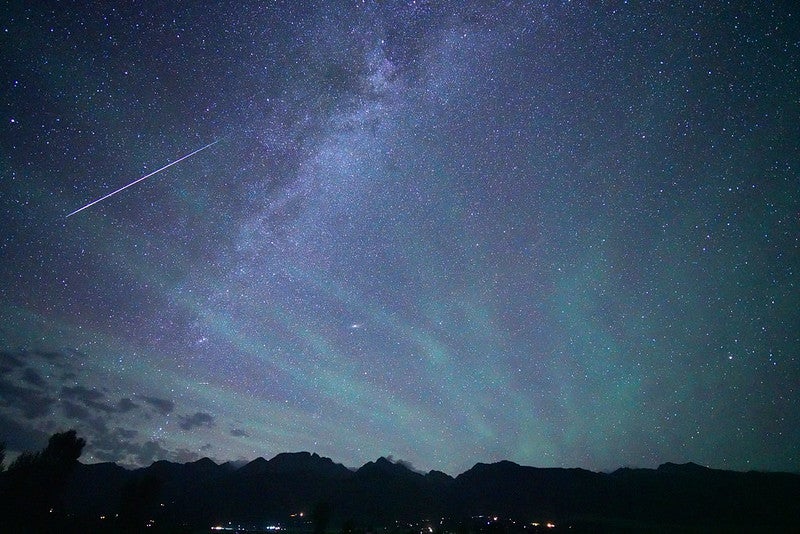
Friday, July 26
With a good dark window between sunset and moonrise, take a look this evening at two famous galaxies: M81 and M82, also known as Bode’s Galaxy and the Cigar Galaxy, respectively.
Both lie in Ursa Major, visible in the north after sunset. Tonight, the Big Dipper is standing on its bowl with the long handle arching upward, on the western side of the North Celestial Pole. Ursa Major, like other constellations in this region, is a circumpolar constellation that appears to circle the North Star, Polaris.
Look with a telescope to the lower right of the Big Dipper’s bowl this evening, about 10° northwest of 2nd-magnitude Dubhe, which marks the upper righthand corner of the bowl. There you’ll find M81, which glows at 7th magnitude and spans about 20′ by 10′. Because it is so bright, this spiral is easy to find even with small beginner scopes.
Just 36′ north of M81 is M82. This irregular disk galaxy is oriented relatively edge-on from our point of view, which makes it look thinner and longer — like a cigar. It spans about 9′ by 4′ and is about a magnitude fainter than M81, but still easily to view in a small scope. In fact, try dropping in a low-power eyepiece or looking through your finder scope — a wide field of view will easily show both galaxies together. They are not only apparently close but are truly close in space, interacting with each other gravitationally after a recent (cosmically speaking) close pass. M82 in particular is undergoing a fervent burst of star formation following the interaction.
Sunrise: 5:54 A.M.
Sunset: 8:19 P.M.
Moonrise: 11:27 P.M.
Moonset: 11:59 A.M.
Moon Phase: Waning gibbous (66%)
*Times for sunrise, sunset, moonrise, and moonset are given in local time from 40° N 90° W. The Moon’s illumination is given at 12 P.M. local time from the same location.
Saturday, July 27
Mercury passes 3° south of Regulus at 8 A.M. EDT. You can catch the pair together with bright Venus in the western sky shortly after sunset.
About 30 minutes after sunset, Venus is just 3° high, though its magnitude of –3.9 should keep it relatively easy to spot if your horizon is clear. Magnitude 0.6 Mercury is much fainter but also a little higher — some 5° high at the same time, to Venus’ upper left.
Regulus, Leo’s magnitude 1.4 alpha star, lies just to Mercury’s upper right. It should be one of the first stars to pop out in this region of the sky as twilight falls, but binoculars or any small scope will help you find it even before the unaided eye can see it. The wider field of view of the former (or the finder scope on the latter) should show both the star and Mercury at the same time.
Thought a telescope, Mercury appears just 35 percent lit and spans 9″. Compare that — while you can — with Venus, which displays a disk only slightly larger (10″) but with much more of its surface lit: 97 percent, appearing nearly full.
Last Quarter Moon occurs at 10:52 P.M. EDT tonight, setting the stage for relatively dark morning skies in just a few days when the Southern Delta Aquariid meteor shower peaks — as well as the Perseids in early August.
Sunrise: 5:55 A.M.
Sunset: 8:18 P.M.
Moonrise: 11:54 P.M.
Moonset: 1:13 P.M.
Moon Phase: Waning gibbous (55%)

Sunday, July 28
After the sky grows dark this evening, turn west to look for the Keystone of Hercules — an asterism drawn from four 3rd- to 4th-magnitude stars: Zeta (ζ), Eta (η), Pi (π), and Epsilon (ε) Herculis. The trapezoid they create lies about two-thirds of the way along a line starting at magnitude –0.1 Arcturus in Boötes and ending at magnitude 0 Vega in Lyra.
Our target for tonight — the great globular cluster in Hercules (M13) — lies along the keystone’s western side, just 2.5° south of magnitude 3.5 Eta. M13 is considered the best globular visible in the Northern Hemisphere, and we’ve got a few more months before it disappears from view as the winter sky fully takes over.
M13 can be visible without optical aid on a dark night, but it really shines in a telescope. Any scope will do, but as always, the bigger the better — scopes around 8 inches or larger will start to show structure within this dense ball of stars, rather than making it appear as a fuzzy glow dissolving into pinpricks only at the edges. In total, the cluster spans a good 15′ to 20′ and its hundreds of thousands of stars glow collectively at magnitude 5.8.
Those photographing the cluster may also net a bonus: The 11th-magnitude galaxy NGC 6207 lies just 40′ south of M13.
Sunrise: 5:55 A.M.
Sunset: 8:17 P.M.
Moonrise: —
Moonset: 2:26 P.M.
Moon Phase: Waning crescent (44%)
Monday, July 29
The Moon passes 4° north of Uranus at 2 P.M. EDT. You’ll find the pair in the early-morning skies, some 35° high around 4 A.M. local daylight time.
Uranus lies in far western Taurus, about 5.5° south of the easy-to-spot Pleiades star cluster (M45). The ice giant itself is best observed with binoculars or a telescope, as it glows at a faint magnitude 5.8. As a closer signpost if you’re star-hopping, Uranus is some 1.5° west of a pair of 6th-magnitude stars: 13 and 14 Tauri.
The planet itself is just 4″ across — large enough, though, to help differentiate it from background stars in the same field. Uranus should look more like a tiny disk than a pinpoint star and may appear a flat, grayish in color to the eye.
The waning Moon, meanwhile, is some 4.7° to Uranus’ upper right (northwest) this morning, just over the celestial border in Aries. As it makes its way into Taurus later in the day, our satellite will occult several stars — Eta, 27, 17, and 20 Tau — for observers in southeast Asia, Indonesia, and western Australia. If you live in these locales, check out the International Occultation Timing Association’s website for 2024 bright star occultations for more details on the timing and visibility from your location.
Sunrise: 5:56 A.M.
Sunset: 8:16 P.M.
Moonrise: 12:25 A.M.
Moonset: 3:40 P.M.
Moon Phase: Waning crescent (33%)
Tuesday, July 30
The Moon continues through Taurus at a good clip, passing 5° north of Mars at 7 A.M. EDT. Some 13 hours later, Luna passes 5° north of Jupiter at 8 P.M. EDT.
Let’s check out the scene again in the early morning, when the Moon lies east of the Pleiades and north of Mars, which itself stands 6° above Aldebaran, the red giant “eye” of the Bull. The Red Planet glows at magnitude 0.8, spanning 6″ on the sky and sitting just 10′ or so from 5th-magnitude Omega (ω) Tau. The Moon is now a 26-percent-lit waning crescent, with only its western limb illuminated.
To the lower right of both Mars and the Moon is magnitude –2.1 Jupiter. The mighty king of planets spans 35″ and is flanked by its Galilean moons: Ganymede and Europa to the east, while Callisto lies to the west.
The eastern half of the U.S. might also catch sight of Io to Jupiter’s west; the small moon passes into the planet’s shadow just before 3:40 A.M. EDT, disappearing from view while it is still some 15″ from the planet’s western limb. The moon will continue moving west to east, passing behind the planet itself around 4:45 A.M. EDT. It won’t reappear until shortly before 5 A.M. MDT, after the Sun has already risen farther east.
Meanwhile, take the time also to spot Ganymede passing due north of Europa (as the former is moving from west to east) around 4:40 A.M. EDT. Earlier than this, Ganymede is slightly closer to Jupiter than Europa; afterward, it pulls farther away.
Sunrise: 5:57 A.M.
Sunset: 8:15 P.M.
Moonrise: 1:02 A.M.
Moonset: 4:51 P.M.
Moon Phase: Waning crescent (23%)
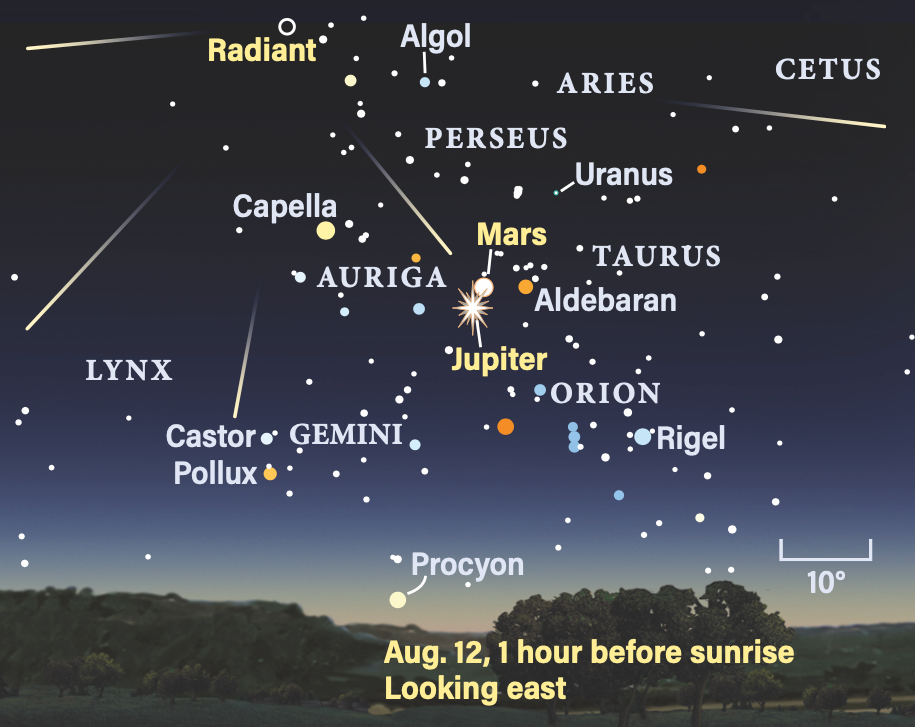
Wednesday, July 31
The Southern Delta Aquariids peak today with a maximum zenithal rate of 25 meteors per hour. The best time to try to spot shower meteors is in the early-morning hours, when the radiant — the spot on the sky from which meteors appear to streak away — is relatively high and the regions on Earth that are headed for daylight are rotating into the meteoroid stream.
Try around 3 A.M. local daylight time, when the radiant stands a little more than 30° high in the south. The radiant is in the southwestern regions of Aquarius, just 6° east of 3rd-magnitude Deneb Algedi in Capricornus. You can expect to see about 12 or so meteors per hour at this time though note the waning Moon might mask some of the fainter ones. Try looking a little way away from Aquarius, to either side, for the best chances of catching longer bright trains left as the meteors vaporize in our atmosphere.
The shower’s peak also coincides with the peak of the much weaker Alpha Capricornids, whose radiant lies in northwestern Capricornus. That shower’s maximum zenithal rate is only 5 meteors per hour; ultimately, it may add a meteor or two per hour to those you see coming from Aquarius.
The Southern Delta Aquariids are medium-fast meteors that zip through our atmosphere with an average speed of 26 miles (41 kilometers) per second. They are generated by debris left behind by Comet 96P/Machholz, which orbits the Sun every 5.3 years. The Alpha Capricornids, despite originating from a similar region on the sky, are borne of Comet 169P/NEAT, which has a period of 4.2 years. These are much slower-moving meteors, with speeds of 15 miles (24 km) per second.
While you’re waiting for meteors to streak overhead, you can check out the ringed planet Saturn, which glows at magnitude 0.7 in eastern Aquarius. It’s the brightest object in this region of the sky, even outshining magnitude 1.2 Fomalhaut in Piscis Austrinus. Although you’ll want to scan the sky with unaided eyes to spot meteors, do take a few minutes to zoom in on Saturn with your telescope; the planet spans 19″ and its rings stretch roughly 42″ end to end. Its brightest moon, Titan, lies about 1′ east of the planet this morning; we’ll return to check out the scene tomorrow morning, when Titan transits Saturn’s southern pole.
Sunrise: 5:58 A.M.
Sunset: 8:14 P.M.
Moonrise: 1:48 A.M.
Moonset: 5:56 P.M.
Moon Phase: Waning crescent (15%)
Thursday, August 1
Let’s head back to the southern sky early this morning to catch Saturn’s largest and brightest moon, 8th-magnitude Titan, transiting the far southern regions of the ringed planet’s disk.
The moon begins transiting Saturn’s disk around 1:15 A.M. EDT (so, early on the 1st for the eastern half of the U.S. only, and shortly after the planet has risen on the 31st for those on the West Coast). Titan takes just over two hours to cross and about an hour into its journey, 10th-magnitude Dione joins in, a bit farther north (though still south of the rings). Those with very sharp eyesight and good seeing — or taking video-capture frames — may also spot Dione’s shadow already on the cloud tops, leading the smaller moon across.
In the leadup to the event, observers in the eastern half of the U.S. especially can catch 10th-magnitude Tethys reappearing from behind Saturn’s eastern limb just north of the rings moments before 11:45 P.M. EDT (on the 31st). The planet is only some 7° high in the Midwest, so might be more challenging to view from this region. Tethys continues moving east just above the rings, passing north of Dione (as it’s moving west beneath the rings) around 12:50 A.M. EDT (on the 1st in the Eastern time zone only). By around 1:45 A.M. EDT, Tethys has cleared the edge of the ring system and continues east, approaching similarly 10th-magnitude Rhea, farther east.
For those with larger scopes and good seeing, an even more challenging observation will be spotting 13th-magnitude Mimas similarly reappearing from occultation behind Saturn just north of the rings on the planet’s eastern side. This occurs around 3:35 A.M. EDT.
Sunrise: 5:59 A.M.
Sunset: 8:13 P.M.
Moonrise: 2:42 A.M.
Moonset: 6:51 P.M.
Moon Phase: Waning crescent (8%)
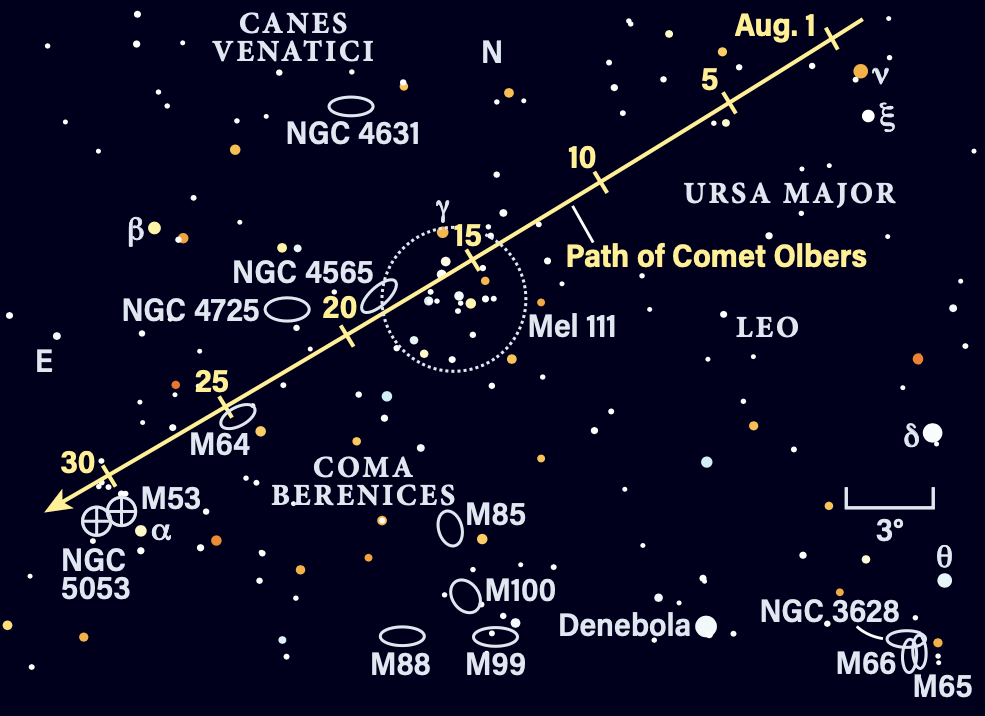
Friday, August 2
Comet 13P/Olbers is passing through southeastern Ursa Major, standing roughly 1.5° from magnitude 3.5 Nu (ν) Ursae Majoris this evening.
The best time to catch the comet is early evening, as the sky starts to grow dark. An hour after sunset, Olbers is still 25° high in the west, about halfway along a line drawn between Denebola, the tip of Leo the Lion’s tail, and Phecda, the lower lefthand corner of the Big Dipper’s bowl.
Last recorded around 7th magnitude, the comet is reachable but getting tougher for binoculars; it’s still quite readily visible in a telescope. The tail should appear a bit stubby and fanned out to the north, while the southern portion of the coma appears well defined. It should still appear green in photographs, as it’s only just a bit farther from the Sun than Earth (about 1.3 astronomical units, where 1 astronomical unit — or AU — is the average Earth-Sun distance). Northern Hemisphere observers will be able to enjoy it for a few more months, though it will continue fading at a decent clip now, as it reached perihelion (the closest point in its orbit to the Sun) just over a month ago and is now heading away from our star.
Olbers will also slide southeast over the coming weeks, moving from Ursa Major into Coma Berenices for a rendezvous with the Coma Star Cluster (Melotte 111) around midmonth.
Sunrise: 6:00 A.M.
Sunset: 8:12 P.M.
Moonrise: 3:44 A.M.
Moonset: 7:37 P.M.
Moon Phase: Waning crescent (3%)

Sky This Week is brought to you in part by Celestron.



